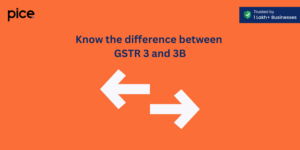How to Calculate Aggregate Turnover for GST Registration
- 12 Aug 24
- 20 mins

How to Calculate Aggregate Turnover for GST Registration
Key Takeaways
- Aggregate turnover includes all taxable, exempt, export, and interstate supplies, crucial for GST compliance and registration.
- The GST registration threshold is ₹40 lakhs for goods and ₹20 lakhs for services, with lower limits for special category states.
- Eligibility for the Composition Scheme requires an aggregate turnover below ₹1.5 crore, offering simpler compliance and lower tax rates.
- To opt for the composition scheme, eligible businesses must file Form GST CMP-02, benefiting from reduced compliance burdens.
- Calculating aggregate turnover involves summing all taxable, exempt, and export supplies while excluding taxes and inward supplies on reverse charge.
- Regular GST return filing is essential for legal compliance, accurate tax liability assessment, and availing input tax credit.
In the realm of the Goods and Services Tax (GST) framework, having knowledge of the concept of aggregate turnover is pivotal for businesses.

It encompasses all of an entity's revenue, which is essential for determining GST registration eligibility and compliance obligations.
This introductory section explores the meaning of turnover and its importance within the GST system.
Components of Aggregate Turnover
- Taxable Supplies: These are the supplies on which GST is applicable. Taxable supplies include all goods and services sold or provided that are subject to tax under GST, excluding those specifically exempt or otherwise not covered by GST.
- Exempt Supplies: These are the supplies of goods and services that are not taxable under GST. Despite not contributing to tax revenue, exempt supplies are included in the calculation of aggregate turnover. Items that are specifically exempt from GST by law fall under this category.
- Non-Taxable Supplies: Supplies that are outside the purview of GST entirely fall into this category. Due to the fact that they are subject to different laws outside of GST, non-taxable supplies are distinct from exempt supplies and do not attract GST.
- Exports of Goods and Services: The total value of goods and services exported outside the country's borders is considered part of the aggregate turnover. Exports are treated as zero-rated supplies under GST, meaning they are taxable, but the tax rate is set to zero, allowing businesses to claim refunds on the input tax credit.
- Reverse Charge Supplies: Certain supplies are taxable under the reverse charge mechanism (RCM), where the recipient of the goods or services is liable to pay GST instead of the supplier. The value of supplies under RCM also counts towards the aggregate turnover.
- Deemed Supplies: Under GST, certain transactions without consideration are also treated as supplies, known as deemed supplies. Examples include self-supplies between branches in different states. The value of these deemed supplies is included in the aggregate turnover.
Exclusions from Aggregate Turnover
While calculating aggregate turnover, it's essential to exclude:
- Taxes and cesses directly charged on the supply of goods or services, such as the GST itself.
- The value of inward supplies on which tax is paid under reverse charge mechanism (RCM), as this does not constitute turnover generated by the business itself.
- Transactions in securities, being outside the scope of GST, are not included in the aggregate turnover.
Annual Threshold Limit for Registration
The Annual Threshold Limit for Registration is a crucial concept in the Goods and Services Tax (GST) framework, signifying the revenue threshold beyond which businesses are required to register under GST. The GST Council sets this limit, which varies depending on the nature of the supply and the business's location.
Understanding this threshold is essential for businesses to comply with GST regulations, as it determines their eligibility for GST registration.
Overview of the Annual Threshold Limit
The threshold limit for GST registration is designed to exempt small traders and service providers from the burden of GST compliance, aiming to simplify the tax regime for small businesses.
The GST Council periodically reviews and adjusts the limit while taking inflation and economic factors into account.
Threshold Limits Across India
- For Goods: The threshold limit for the mandatory registration of suppliers dealing in goods is generally limit of ₹40 lakhs (₹4 million). However, for special category states (typically hilly and North-Eastern states), the limit is at ₹20 lakhs (₹2 million) to account for their unique economic conditions.
- For Services: Service providers across India are required to register for GST if their aggregate turnover exceeds ₹20 lakhs (₹2 million). In special category states, this limit is reduced to ₹10 lakhs (₹1 million), making it essential for service providers in these regions to monitor their revenue closely.
Special Considerations
- Composition Scheme: Small businesses with an aggregate turnover of up to ₹1.5 crore (₹15 million) can opt for the Composition Scheme, which allows them to pay GST at a fixed rate of their turnover, thereby simplifying compliance and tax calculations. This limit is ₹75 lakhs (₹7.5 million) for special category states.
- Voluntary Registration: Businesses that do not cross the prescribed threshold limit can still opt for voluntary GST registration. This allows them to avail of the benefits of the GST regime, such as the input tax credit.
- Exemptions: Certain categories of suppliers are exempt from the registration threshold, including interstate suppliers, persons required to pay tax under the reverse charge mechanism, and those supplying goods and services through e-commerce operators.
Implications of Not Registering

Failing to register for GST upon crossing the annual threshold limit can result in penalties, interest on unpaid taxes, and a denial of input tax credit for the business. Therefore, it is imperative for businesses to monitor their aggregate turnover and ensure timely registration to comply with GST laws.
Eligibility for GST Registration
Eligibility for GST (Goods and Services Tax) registration is a key aspect of compliance under the GST regime in India, which has been designed to unify the country's indirect tax system. GST registration is mandatory for businesses that meet certain criteria based on their annual aggregate turnover and the nature of their transactions.
These eligibility criteria is crucial for businesses to ensure they comply with the law, avoid penalties, and take advantage of the benefits of being a registered entity under GST.
Criteria for Mandatory GST Registration
Aggregate Turnover Threshold:
Businesses whose aggregate turnover exceeds the prescribed threshold limit are required to register for GST. The current threshold is ₹20 lakhs (₹2 million) for service providers and ₹40 lakhs (₹4 million) for suppliers of goods in most states, with a reduced threshold of ₹10 lakhs (₹1 million) for service providers and ₹20 lakhs (₹2 million) for suppliers of goods in special category states, which include northeastern states, Uttarakhand, Himachal Pradesh, and Jammu & Kashmir.
- Inter-state Supplies: Businesses involved in the supply of goods or services across state borders are required to register for GST, irrespective of their turnover.
- E-commerce Operators and Suppliers: Sellers and operators on e-commerce platforms are required to obtain GST registration regardless of their aggregate turnover.
- Reverse Charge Mechanism (RCM): Entities that are required to pay tax under the reverse charge mechanism need to register for GST. Under RCM, the recipient of goods or services is liable to pay GST instead of the supplier.
- Casual Taxable Persons and Non-Resident Taxable Persons: Those who occasionally undertake transactions involving the supply of goods or services in a territory where GST is applicable, but who do not have a fixed place of business, are considered casual taxable persons. Similarly, non-resident taxable persons supplying goods or services in India must register for GST.
- Agents and Input Service Distributors: Individuals or businesses acting as agents for other registered taxpayers, as well as input service distributors, are required to register under GST.
- Those Paying Tax under the Composition Scheme: Small businesses that opt for the GST Composition Scheme, which allows them to pay tax at a fixed rate based on turnover, must register for GST. This scheme is available to businesses with an annual turnover of up to ₹1.5 crore (₹15 million), or ₹75 lakhs (₹7.5 million) in special category states.
Voluntary Registration
Businesses that do not meet the mandatory criteria may choose to register for GST voluntarily. Voluntary registration has its advantages, such as the ability to claim input tax credit, becoming part of the formal economy, and fostering trust with business partners.
Consequences of Not Registering
Failing to register for GST when required can lead to penalties, including fines and legal action. Moreover, businesses may be unable to claim input tax credit, which can lead to increased costs.
Eligibility to Avail Benefit of Composition Scheme
This section addresses how aggregate turnover influences a business's eligibility to avail the Benefit of Composition Scheme, a simplified tax scheme under GST designed for small taxpayers to reduce compliance costs.
Eligibility Criteria for the Composition Scheme
- Aggregate Turnover Threshold: The primary criterion for eligibility is the aggregate turnover of the business. A taxpayer whose aggregate turnover does not exceed ₹1.5 crore (₹15 million) in the previous financial year can opt for the Composition Scheme. For businesses located in the special category states, the threshold limit is ₹75 lakhs (₹7.5 million). This threshold is subject to review and updates by the GST Council.
- Type of Business: The scheme is available to manufacturers, traders, and restaurant services. However, service providers (other than restaurant services) were initially excluded but have been included with a threshold of ₹50 lakhs (₹5 million) under specific conditions as per the latest amendments.
- Inter-state Supplies: Businesses opting for the Composition Scheme are not allowed to engage in inter-state supplies of goods. This means they can only supply goods within their own state or Union Territory.
- E-commerce Sales: Taxpayers who supply goods through e-commerce platforms are ineligible for the Composition Scheme, as these sales often imply inter-state transactions.
- Other Ineligibilities: Businesses that supply non-taxable goods, execute transactions under the reverse charge mechanism, or are involved in making any supply of goods that are not leviable to tax under GST cannot opt for this scheme.
Benefits of the Composition Scheme
- Simplified Compliance: Taxpayers benefit from reduced record-keeping requirements and are required to file quarterly returns instead of monthly, simplifying the compliance process.
- Lower Tax Rates: The scheme offers the benefit of lower tax rates ranging from 1% to 5%, depending on the type of business (1% for manufacturers and traders, 5% for restaurant services).
- Reduced Tax Liability: The lower rates effectively reduce the tax liability for small businesses, making it an attractive option for eligible taxpayers.
Limitations of the Composition Scheme
- Restriction on Input Tax Credit (ITC): Businesses opting for this scheme cannot claim input tax credit, which could be a significant drawback for those with substantial input taxes.
- No Inter-state Sales: The inability to engage in inter-state sales limits the market reach of businesses under the Composition Scheme.
- Taxpayer Confined to Local Sales: Since the scheme restricts sales to within the state, businesses aiming for a broader market presence might find this restrictive.
Opting for the Composition Scheme
Opting for the Composition Scheme under the Goods and Services Tax (GST) regime is a strategic decision for small taxpayers seeking to simplify their tax compliance processes. The Composition Scheme allows eligible businesses to pay GST at a reduced rate on their turnover, without the need to follow the detailed compliance requirements applicable to regular taxpayers.
Here's a detailed look into how businesses can opt for the Composition Scheme, along with its benefits and considerations.
Steps to Opt for the Composition Scheme
- Check Eligibility: Before opting in, ensure that your business meets the eligibility criteria for the Composition Scheme, which primarily revolves around the aggregate turnover threshold and the nature of the business operations.
- Intimation to GST Authorities: To opt for the Composition Scheme, eligible taxpayers must file an intimation with the GST authorities. To do this, submit Form GST CMP-02 on the GST portal, indicating your intention to choose the scheme for the upcoming fiscal year. should be done at the beginning of the financial year.
- Furnishing Statement of Stock: Taxpayers opting for the Composition Scheme need to furnish details of the stock, including the inward supply of goods from unregistered persons, on the date preceding the date from which they opt for the scheme. This is done through Form GST CMP-03.
- Effective Date of Composition Levy: For businesses newly registering under GST and opting for the Composition Scheme, the scheme becomes effective from the date of registration. For existing taxpayers, it becomes effective from the beginning of the next financial year.
- Compliance with Scheme Rules: Once opted in, businesses must comply with the rules and regulations of the Composition Scheme, such as not making interstate supplies, not supplying exempt goods, and not collecting GST from customers.
Benefits of Opting for the Composition Scheme
- Simplified Tax Compliance: Reduces the burden of monthly GST returns and allows businesses to file quarterly returns instead.
- Lower Tax Rates: Businesses can benefit from significantly lower tax rates compared to the standard GST rates, which can range from 1% to 5%, depending on the type of business.
- Reduced Compliance Costs: With simplified compliance requirements, businesses can save on the costs associated with GST filings and record-keeping.

Considerations Before Opting In
- Restriction on Input Tax Credit: Businesses under the Composition Scheme cannot claim input tax credit, which could affect profitability if the business has significant input taxes.
- No Interstate Supplies: The scheme restricts businesses from making interstate supplies, limiting the market reach to within the state boundaries.
- Tax Invoicing Restrictions: Composition dealers cannot issue tax invoices; instead, they issue a bill of supply, which means they cannot collect GST from customers.
Opting Out of the Composition Scheme
Businesses can opt out of the Composition Scheme by filing Form GST CMP-04 if they no longer meet the eligibility criteria or if they choose to revert to the regular GST scheme for any reason. It is important to carefully consider the benefits and limitations of the Composition Scheme in relation to your business model and compliance capabilities before making a decision.
Opting for the Composition Scheme offers a pathway for small businesses to ease their tax burdens and simplify compliance. However, the decision to opt in should be made after a thorough analysis of the business's financial operations, market scope, and long-term strategy concerning GST compliance.
Calculating Aggregate Turnover under GST
Calculating aggregate turnover under the Goods and Services Tax (GST) is a foundational step for businesses to determine their tax obligations, eligibility for various schemes, and compliance requirements.
Aggregate turnover is a broad way to look at a company's income. It includes all of its taxable, non-taxable, exempt, and exported goods and services, but not supplies coming in under the reverse charge mechanism or taxes levied by the central government, states, union territories, and the GST regime.
Here's a guide on how to calculate aggregate turnover under GST.
Understanding Aggregate Turnover
Aggregate turnover includes:
- Taxable Supplies: Sales of goods and services subject to GST.
- Exempt Supplies: Sales of goods and services that are exempt from GST.
- Exports of Goods and Services: Goods and services sold to locations outside India.
- Interstate Supplies: Goods and services sold from one state to another within India.
- Supplies between Distinct Persons: Transactions between branches or divisions of the same business in different states or taxable territories, based on GST registration.
Exclusions from Aggregate Turnover
When calculating aggregate turnover, the following are excluded:
- Inward supplies on which tax is paid under the reverse charge mechanism (RCM).
- Central, state, integrated, and union territory GST taxes, and cess.
- Transactions in securities.
Step-by-Step Guide to Calculating Aggregate Turnover
Step 1: Compile All Revenues
Gather data on all your revenues from the sale of goods and services within the financial year across all your business operations in India. This includes taxable, exempt, and export supplies.
Step 2: Include Interstate Supplies
Ensure that interstate supplies, including supplies to branches or related entities in different states, are included in your total revenue figures.
Step 3: Add Supplies between Distinct Persons
Include the value of supplies made between distinct persons as per GST, which refers to transactions between the same entity's branches in different states.
Step 4: Exclude Inward Supplies under RCM
Do not include the value of inward supplies where your business is liable to pay tax under the reverse charge mechanism.
Step 5: Exclude Taxes
Deduct the value of central, state, integrated, and union territory GST taxes from your revenue figures. Only the base value of the supplies is to be considered.
Step 6: Aggregate All Branches
If your business operates through multiple branches or divisions, aggregate the turnovers of all units to get the total turnover. This is crucial for businesses with operations across different states.
Step 7: Double-Check Exempt and Export Supplies
Verify that all exempt supplies and exports are accurately included in your calculations, as these can significantly impact your aggregate turnover.
Regular Monitoring
It's important for businesses to regularly monitor their aggregate turnover throughout the year, especially close to the threshold limits for GST registration and eligibility for the Composition Scheme. This ensures timely compliance and makes strategic decisions regarding GST registration and scheme eligibility.
Examples of Aggregate Turnover Calculation
Aggregate turnover is essential for determining GST registration requirements, eligibility for the Composition Scheme, and other GST-related obligations. Here are some examples to demonstrate the calculation of aggregate turnover in different contexts.
Example 1: Single-State Operation
Let's consider a manufacturer, A, operating only in the state of Maharashtra. The business has various revenue streams throughout the financial year:
- Taxable supplies: ₹30,00,000
- Exempt supplies: ₹5,00,000
- Export of goods: ₹15,00,000
- Inward supplies under RCM: ₹4,00,000 (To be excluded)
- CGST/SGST on outward supplies: ₹5,40,000 (To be excluded)
Calculation: Aggregate Turnover = Taxable supplies + Exempt supplies + Export of goods Aggregate Turnover = ₹30,00,000 + ₹5,00,000 + ₹15,00,000 Aggregate Turnover = ₹50,00,000
Example 2: Multi-State Operation with Inter-State Supplies
Business B operates in two states, Karnataka and Tamil Nadu, with the following revenues:
Karnataka:
- Taxable supplies: ₹20,00,000
- Exempt supplies: ₹3,00,000
- Tamil Nadu:
- Taxable supplies: ₹25,00,000
- Exempt supplies: ₹2,00,000
- Inter-state supplies from Karnataka to Tamil Nadu: ₹10,00,000
Calculation: Aggregate Turnover = Sum of all supplies across both states Aggregate Turnover = (₹20,00,000 + ₹3,00,000) + (₹25,00,000 + ₹2,00,000) + ₹10,00,000 Aggregate Turnover = ₹60,00,000
Note: Inter-state supplies are included in the total turnover and not considered separately for each state.
Example 3: Inclusion of Supplies between Distinct Persons
Company C has branches in Gujarat and Maharashtra. It supplies to its own branch in another state:
Gujarat Branch:
- Taxable supplies: ₹18,00,000
- Supplies to Maharashtra branch (considered as inter-state supplies): ₹2,00,000
- Maharashtra Branch:
- Taxable supplies: ₹22,00,000
Calculation: Aggregate Turnover = Supplies in Gujarat + Supplies to Maharashtra + Supplies in Maharashtra Aggregate Turnover = ₹18,00,000 + ₹2,00,000 + ₹22,00,000 Aggregate Turnover = ₹42,00,000
Example 4: Exporter with No Domestic Sales
Exporter D focuses solely on international markets, with no domestic sales. The financial year records:
- Export of goods: ₹50,00,000
- Export of services: ₹20,00,000
Calculation: Aggregate Turnover = Export of goods + Export of services Aggregate Turnover = ₹50,00,000 + ₹20,00,000 Aggregate Turnover = ₹70,00,000
Regular GST Return Filing
It connects the dots between maintaining an accurate aggregate turnover figure and fulfilling GST return filing requirements, underscoring the critical role of timely and accurate submissions.
Significance of Regular GST Return Filing

- Compliance: Regular filing of GST returns is mandatory for all registered businesses to comply with GST laws. Non-compliance can lead to penalties and affect the creditworthiness of the business.
- Tax Liability Assessment: Returns help in assessing the tax liability of a business for a specific period.
- Input Tax Credit: Filing returns accurately and timely is crucial for availing of the input tax credit, which is the tax paid on purchases that can be deducted from the tax liability on sales.
- Transparency and Accountability: Regular filing promotes transparency in business operations and holds businesses accountable for their tax liabilities.
Types of Regular GST Returns
- GSTR-1: Filed by registered taxpayers to report their sales or outward supplies. This return is due monthly for businesses with aggregate turnover above ₹1.5 crore and quarterly for those with turnover up to ₹1.5 crore.
- GSTR-2A: An auto-populated return detailing the purchases of a taxpayer, based on the information filed in GSTR-1 by their suppliers. It aids in the verification and availing of input tax credit.
- GSTR-3B: A monthly summary return filed by registered taxpayers, summarizing their outward supplies, inward supplies liable to reverse charge, and availing input tax credit. GSTR-3B is crucial for the payment of tax liabilities.
- GSTR-4: Filed by taxpayers who have opted for the GST Composition Scheme, reporting their quarterly tax payments and turnover details. This return simplifies compliance for small taxpayers.
- GSTR-9: An annual return that consolidates the information furnished in the monthly or quarterly returns. It provides a comprehensive overview of a taxpayer's annual activities.
Process of Regular GST Return Filing
- Collect and Organize Data: Gather all invoices related to sales, purchases, and expenses. Organizing data monthly helps streamline the filing process.
- Reconcile Transactions: Reconcile your sales and purchase transactions with the corresponding GSTR-2A to ensure accuracy in claiming input tax credits.
- File Returns Online: Log in to the GST portal and fill out the necessary forms. For GSTR-1 and GSTR-3B, details of outward supplies, inward supplies, and tax liability must be accurately reported.
- Pay Tax Due: After filing returns, any tax due should be paid through the GST portal. To avoid penalties, make sure to pay by the due date.
- Keep Records: Maintain records of all filed returns and tax payment receipts for future reference and compliance checks.
Conclusion
Reviewing aggregate turnover helps businesses stay compliant with GST regulations, avoid penalties, and make strategic decisions regarding their tax liabilities and benefits.
Ensuring timely GST return filings, based on accurate aggregate turnover calculations, enhances transparency, accountability, and the potential to claim input tax credits, contributing to the overall financial health and compliance status of the business.
💡Learn more about how our PICE business payment application can help business owners use their credit cards to pay any and all business expenses. . Download the app now .




















